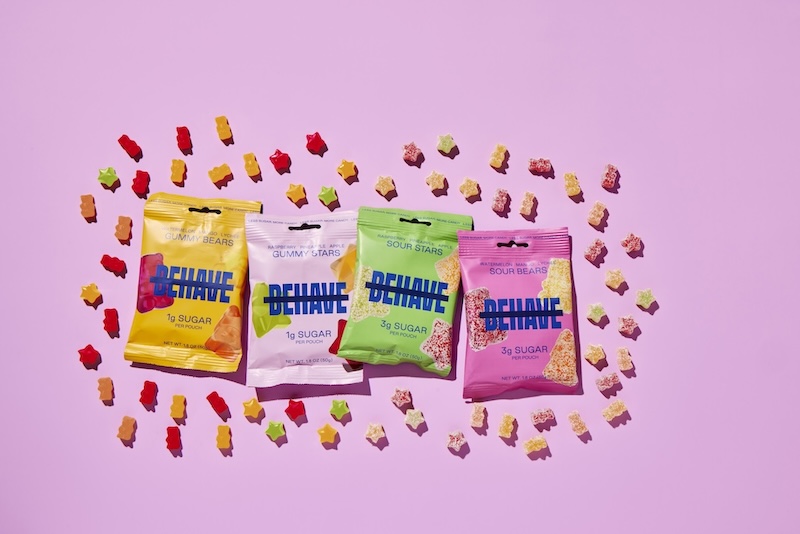How CPG startups reformulated their products this year

Just three years after launching, better-for-you candy brand Behave relaunched in September with new flavors and updated packaging to prepare for its next phase of growth. The changes Behave made included lowering the price per pouch of its gummies and introducing new flavors to better appeal to a wider variety of customers as it entered more conventional retail channels.
“To really disrupt this category and scale, we knew we had to pivot sooner rather than later and come back to the market with a much wider appeal,” Behave founder Mayssa Chehata said.
Behave’s not alone in making tweaks to its core products. Other CPG brands like Ghia and Cabi also reformulated some of their products this year to better appease retail buyers, and appeal to a wider variety of customers. According to brands executives, reformulating recipes and creating new packaging is an expensive upfront investment. However, these major relaunches are often necessary for a young startup when trying to transition from being a DTC-only brand to selling through brick-and-mortar. After a few years in business, brands are more likely to have gathered feedback about what people like and don’t like about the product, and can adjust accordingly.
Last April, non-alcoholic aperitif brand Ghia also relaunched with a new recipe and bottle size, after initially debuting in 2020. The company reformulated its top-selling flavor with custom extracts that makes for a 46% stronger concentrate; the new aperitif now boasts 17 servings per bottle compared to the previous iteration of 10. For Ghia, which said it experiences 77% year-over-year growth in 2023, reworking the formula of its signature non-alcoholic aperitif helped it “fit in even better” next to traditional amaros and spritzes. In the relaunch release, Ghia founder Melanie Masarin said with the reformulation being more concentrated, “a little bit goes a long way, the color is brighter, the bottle is bolder, and it’s more inclusive and approachable.”
Chehata said that early on, Behave’s focus was on “getting to know our community for the first year or so to collect as much feedback as possible,” primarily through surveys and customer interviews.
A couple of big requests came up consistently. “First and foremost was lowering the price,” Chehata said, which deterred a lot of customers from repurchasing the product, even if they loved it. “We worked diligently across our supply chain to lower costs and pass on the savings to the customer,” she said, including working with a large candy manufacturer.
This reduced the price from $5 per gummy pouch to $3.50 at retailers nationwide. Behave also created a four-pack variety pack for $15. The packaging also got a redesign, moving away from Behave’s original minimalist pouches featuring just the brand’s name. “We added images of the gummies to the package,” Chehata said. “We were hearing from our retailers that the product moves well but would do better if people can tell right away what’s inside.”
“Through one-on-one interviews, we learned that a lot of our most loyal customers came to Behave due to a health concern requiring them to cut back on sugar,” she said. Going forward, the company will increase efforts to build a community around health without giving up sweets.
Formulation of taste and flavors was the other big update based on feedback. “We’re still using generally the same sweetener and maintaining a clean ingredient label,” she said, which is promoted as diabetes and PCOS-friendly. The company also introduced more classic gummy flavors like apple and watermelon, to expand on the out-of-the-box combinations like lychee and pineapple.
Chehata said the company’s products have performed well at high-end, natural grocers like Erewhon and Foxtrot. But with the company expanding into more conventional retailers and on Amazon, Chehata said “that’s when we got constructive criticism back around the pricing and taste.”
Similarly, Japanese condiment brand Cabi started to rethink some of its products as it ventured more into physical stores. When Cabi launched in 2022, co-founder Eri Miyagi envisioned the brand would sell through DTC for a while before launching into retail.
“Even a year ago, selling online was more viable,” Miyagi said, citing increasing costs of digital advertising and online fulfillment. The brand began rolling out in select retailers this year, and is now available at about 400 stores including at The Fresh Market stores; Wholesale is almost 80% of Cabi’s business now, thanks to orders through platforms like Faire.
One major move was lowering prices to lower the barrier of entry on the shelf. “We also worked to make the suggested retail price consistent as we expand into more doors,” she said. Cabi bottles now cost $12.99 compared to the launch date price of $14.99. “Everything is produced in Japan where we’ve been able to negotiate and streamline production with our fermentation partners,” Miyagi said.
Moreover, the brand’s best-selling product isn’t the one Miyagi imagined it would be — leading the company to shift focus to one SKU, having launched with three products. “We thought the yuzu vinegar would be the most popular, but people are responding to the soy sauce the most,” Miyagi said.
Despite the large investment early on, these companies are betting on helping them grow more in the long term. “There has been a lot of learning since we launched that we’re applying as we transition from online to retail,” Miyagi said.
As Behave plots its next phase of growth, Chehahta said the reformulated product will allow the company to more easily enter new distribution points outside of grocers, like movie theaters, hotel minibars, convenience stores and entertainment venues. “We’ve launched a partnership with Live Nation, so you’ll see us at select Live Nation venues,” she said.
Next on the Behave product pipeline are new shapes and a line of plant-based gummies, and later on, other candy lines outside gummies. “The hardest thing, especially as a small business, is to make changes without compromising on quality and brand values,” Chehata said.

